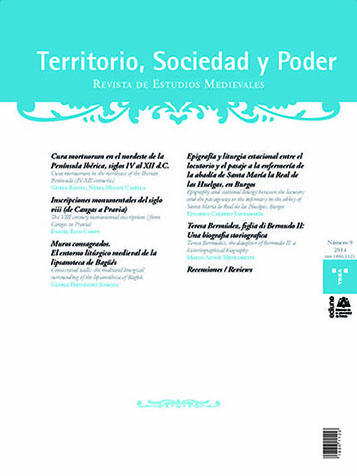Resumen
Resumen: De la infanta Teresa, hija del rey leonés Bermudo II , tenemos pocas informaciones históricas. Se la conoce también por su matrimonio con un “rey musulmán”, aunque, según la historiografía moderna, esto es por lo menos dudoso. Nos queda la transcripción de su inscripción funeraria, que hasta el siglo XVIII se encontraba en el monasterio de San Pelayo de Oviedo, donde murió, que es lo más parecido que tenemos a la narración de su vida si no tenemos en cuenta el episodio de su casamiento. Este artículo intenta reconstruir lo que sabemos sobre ella, y de dar una visión completa sobre los hechos (reales o legendarios) vinculados a este personaje, a través de una panorámica que tenga en cuenta de todo lo que ha sido escrito sobre Teresa al interior de la historiografía moderna y contemporánea.
Palabras clave: Teresa Bermúdez, Bermudo II , Almanzor, crónicas medievales, Memoria.
Abstract: Little is known about Teresa Bermúdez, daughter of Bermudo II of León. Some medieval chronicles, written in the Iberian Peninsula, tell us about her alleged marriage with a Muslim king of Toledo, while others believe this was al-Mansur (or Almanzor), a Muslim military chief, after whose death she would have come back to León, ending her life in the monastery of St. Pelagius in Oviedo, a well-known place in medieval times often linked with the infantas of the kingdom (according to a legend, it was founded by king Alfonso II of Asturias, and Velasquita, the first wife of Bermudo II , is also known to have lived there). The main narrative about this event is provided by the Chronicle of Pelagius, bishop of Oviedo, which tells the deeds of the Leonese kings from the age of Bermudo II (985-999) to the death of Alfonso VI (1072-1109), and was later reprised by the Chronicle of Nájera and the “General Histories” of the 13th century. Furthermore, a few documents have been linked to Teresa, as well as her funerary inscription, which has been lost in the 18th century but of which we possess the transcription; it could have been made slightly later, but it gives us a date for the death (and, surprisingly, the time at which it allegedly happened) of the princess-turned-nun. Interestingly, another inscription, dedicated to another nun with the same name, has been found during the excavations of the church of San Salvador in Oviedo (now the Cathedral): it has been tried to identify her with the Bermudo’s daughter, but, given the different dates of death reported by both texts, it is almost impossible to trace a connection between them. Many doubts about the marriage and the existence of Teresa itself were lifted by modern and contemporary historiography, which has tried to define it chronologically and historically, and it has even supposed that her epitaph was later made to provide evidence for the story of Pelagius of Oviedo: this article tries to give an historical perspective about what is certain about the princess and what has been written about her in modern and contemporary works; the need for a sort of “biographical history” for some of the lesser known characters in Spanish medieval history is here also stressed.
Keywords: Teresa Bermúdez, Bermudo II , Almanzor, medieval chronicles, Memory.

